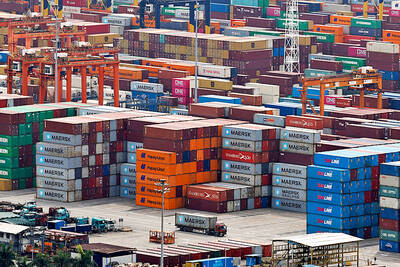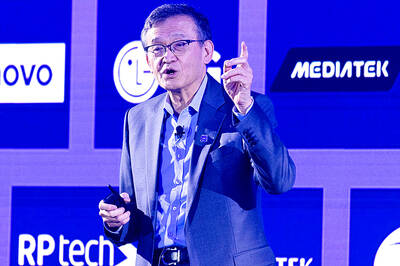Exports of electronics components and products rose more than 27 percent in the first two months year-on-year due to strong overseas demand, an official at the Taiwan Electrical and Electronic Manufacturers Association (TEEMA, 電電公會) said yesterday.
But post-election political turmoil seemed to deter foreign buyers from visiting the Spring Taitronics and TaipeiOpto shows, which began yesterday in Taipei, said an official surnamed Wang at the Taiwan External Trade Development Council (TAITRA).
"Two of our nanotechnology seminars scheduled for the show were called off after the speakers cancelled their trips to Taiwan," Wang said.
The joint exhibitions attracted 400 domestic and foreign companies, occupying 900 booths at the Taipei World Trade Center Exhibition Hall. The exhibitions featured five pavilions and featured technologies such as wireless LAN and digital television under the theme of building a mobile e-Taiwan.
TAITRA, one of the organizers, expected the number of foreign buyers would grow only slightly over last year's event due to the country's political disputes.
Hit by SARS, the show drew over 20,000 buyers last year.
TEEMA chairman Rock Hsu (
"Taiwan's electrical and electronics exports in the first two months of this year amounted to US$9.2 billion, a leap of 27.4 percent year-on-year," he said.
But liquid crystal display (LCD) related products remain a key feature of the show, with Sampo Corp (聲寶), Kolin Co (歌林), Teco Electric and Machinery Co (東元) and Proton Communications Technology Inc (普騰) displaying their latest goods.
"We saw a 20 percent increase in sales of LCD-TVs in Taiwan last year," said Kimi Tai (
Prices for 30-inch LCD-TVs, which became mainstream products last year, will fall to about NT$59,000 per unit, while 32-inch LCD-TVs should be priced as high as NT$100,000 per unit, Tai said.
The LCD-TV sector may see similar growth this year due to stagnant progress with technical specifications as well as price cuts. Sales of digital TVs, however, fuelled by an increase in digital content and digital broadcasts of the Athens Olympics, may triple to 300,000 units this year, he said.
The optoelectronics sector is expect to report a production value of NT$958.6 billion this year, compared with NT$752.2 billion last year, driven by sales of large thin-film-transistor LCD panels, Hsu said.
The exhibition also features technologies enabling mobile-phone users to access the Internet via the GPRS system as well as via wireless LAN (WLAN). WLAN provides faster transmission and lower cost.

The Eurovision Song Contest has seen a surge in punter interest at the bookmakers, becoming a major betting event, experts said ahead of last night’s giant glamfest in Basel. “Eurovision has quietly become one of the biggest betting events of the year,” said Tomi Huttunen, senior manager of the Online Computer Finland (OCS) betting and casino platform. Betting sites have long been used to gauge which way voters might be leaning ahead of the world’s biggest televised live music event. However, bookmakers highlight a huge increase in engagement in recent years — and this year in particular. “We’ve already passed 2023’s total activity and

Nvidia Corp CEO Jensen Huang (黃仁勳) today announced that his company has selected "Beitou Shilin" in Taipei for its new Taiwan office, called Nvidia Constellation, putting an end to months of speculation. Industry sources have said that the tech giant has been eyeing the Beitou Shilin Science Park as the site of its new overseas headquarters, and speculated that the new headquarters would be built on two plots of land designated as "T17" and "T18," which span 3.89 hectares in the park. "I think it's time for us to reveal one of the largest products we've ever built," Huang said near the

China yesterday announced anti-dumping duties as high as 74.9 percent on imports of polyoxymethylene (POM) copolymers, a type of engineering plastic, from Taiwan, the US, the EU and Japan. The Chinese Ministry of Commerce’s findings conclude a probe launched in May last year, shortly after the US sharply increased tariffs on Chinese electric vehicles, computer chips and other imports. POM copolymers can partially replace metals such as copper and zinc, and have various applications, including in auto parts, electronics and medical equipment, the Chinese ministry has said. In January, it said initial investigations had determined that dumping was taking place, and implemented preliminary

Intel Corp yesterday reinforced its determination to strengthen its partnerships with Taiwan’s ecosystem partners including original-electronic-manufacturing (OEM) companies such as Hon Hai Precision Industry Co (鴻海精密) and chipmaker United Microelectronics Corp (UMC, 聯電). “Tonight marks a new beginning. We renew our new partnership with Taiwan ecosystem,” Intel new chief executive officer Tan Lip-bu (陳立武) said at a dinner with representatives from the company’s local partners, celebrating the 40th anniversary of the US chip giant’s presence in Taiwan. Tan took the reins at Intel six weeks ago aiming to reform the chipmaker and revive its past glory. This is the first time Tan